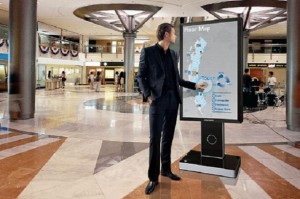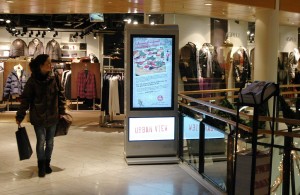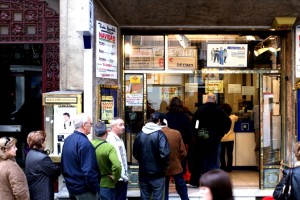Las pantallas digitales ganan la partida a los soportes offline en aeropuertos y centros comerciales
El digital signage se ha convertido en un elemento clave para que las empresas fomenten su imagen de marca. Las pantallas digitales permiten ofrecer información más actualizada y cercana al consumidor que la cartelería tradicional. Publicidad e información de eventos culturales y de ocio son los principales contenidos de estos soportes.
Las pantallas digitales se han convertido en el medio preferido para mostrar información sobre eventos culturales o de ocio o como soporte publicitario, siendo los centros comerciales, estaciones y aeropuertos los lugares donde más proliferan.
IAB Spain, la Asociación que representa al sector de la publicidad y la comunicación digital en España, ha presentado hoy el Segundo Estudio Anual de Digital Signage (cartelería exterior digital) realizado por la empresa Elogia Group y liderado por la Comisión de Digital Signage.
 En el estudio se pone de relieve como las empresas que se anuncian en pantallas digitales consiguen una mejor imagen de marca. And 50% las prefiere frente a un 10% que se decanta por el exterior offline, ya que consideran que las pantallas digitales llaman más la atención y consiguen ofrecer un contenido más actualizado, creativo y útil. Besides, los soportes digitales permiten ofrecer contenidos más vinculados al emplazamiento además de actualizados, frente a los soportes offline.
En el estudio se pone de relieve como las empresas que se anuncian en pantallas digitales consiguen una mejor imagen de marca. And 50% las prefiere frente a un 10% que se decanta por el exterior offline, ya que consideran que las pantallas digitales llaman más la atención y consiguen ofrecer un contenido más actualizado, creativo y útil. Besides, los soportes digitales permiten ofrecer contenidos más vinculados al emplazamiento además de actualizados, frente a los soportes offline.
En lo que respecta a los contenidos que se visualizan en estos displays, el estudio revela que el 60% es publiciario, seguidos de información sobre eventos culturales o de ocio (30%) junto con ofertas y promociones (29%). Esto hace que los usuarios se sientan atraídos y sientan que estos soportes les ofrecen una información útil (47%) y hace que les motive o influya en su decisión de compra (39%).
 El soporte de comunicación testado más notorio es la valla publicitaria (72%), seguido del cartel publicitario (69%). Las pantallas digitales tiene una notoriedad sugerida del 39%, al ilustrarlo con ejemplos, la notoriedad es casi absoluta (93%). El tipo de soporte digital más reconocido es la pantalla digital (87%) seguido de los tótems (79%).
El soporte de comunicación testado más notorio es la valla publicitaria (72%), seguido del cartel publicitario (69%). Las pantallas digitales tiene una notoriedad sugerida del 39%, al ilustrarlo con ejemplos, la notoriedad es casi absoluta (93%). El tipo de soporte digital más reconocido es la pantalla digital (87%) seguido de los tótems (79%).
La inmensa mayoría conoce las pantallas táctiles (93%) y las ubican en centros comerciales, tiendas o estaciones/aeropuertos.
Una cuarta parte de la muestra que conoce la pantalla táctil ha realizado alguna compra (especialmente tickets de transporte, comida rápida a través de kioscos o entradas de espectáculos) y con la valoran de forma positiva ya que consideran que ahorra tiempo. La intención de utilizarla incrementa en caso de encontrarse en una tienda concurrida (83%) and the 57% afirma utilizarlo para realizar compras.
 Según el soporte, se identifican distintas ubicaciones. Mientras que los offline son más propios de exterior (vallas y carteles publicitarios), los digitales se ubican en centros comerciales y estaciones o aeropuertos.
Según el soporte, se identifican distintas ubicaciones. Mientras que los offline son más propios de exterior (vallas y carteles publicitarios), los digitales se ubican en centros comerciales y estaciones o aeropuertos.
El modo de interacción más conocido y usado es el QR, seguido de las pantallas táctiles. Las redes sociales son el tercer modo de interacción conocido y usado especialmente entre los jóvenes.
Entre los que han interactuado a través de canales digitales, de forma espontánea, reconocen que la curiosidad ha sido la motivación.
Did you like this article?
Subscribe to our NEWSLETTER and you won't miss anything.



